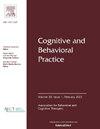Harm Reduction Behavioral Activation Teletherapy for People Who Inject Drugs: Development, Feasibility, and Acceptability
IF 2.9
3区 心理学
Q1 PSYCHOLOGY, CLINICAL
引用次数: 0
Abstract
People who inject drugs (PWID) experience severe substance-related harms and yet have low rates of engagement in substance use disorder treatment. Low-barrier and telepsychology interventions represent promising strategies for engaging PWID in treatment, but few studies have tested the feasibility of these approaches among non-treatment-seeking PWID. A behavioral activation (BA) treatment for substance use was adapted through a harm reduction lens to assist PWID in working toward healthy, meaningful lives and achieving their goals. This study aims to: (a) describe the development and harm reduction–focused adaptation of the BA intervention, and (b) examine the feasibility and acceptability of administering a telepsychology BA treatment for substance use among non-treatment-seeking PWID. We recruited N = 23 PWID (65.2% White; 52.2% women; mean age 35.4 ± 7.8 years) from syringe services programs into an open trial and n = 19 received up to eight sessions of BA over 4 weeks. Qualitative treatment feedback interviews occurred at posttreatment. Among those who attended ≥1 session of treatment, 84% attended a second assessment, and 58% attended ≥7 intervention sessions. Feasibility challenges were primarily related to participant vulnerabilities (e.g., hospitalization, incarceration, loss of access to technology). Participants indicated high acceptance of the intervention and its telepsychology format. In conclusion, while PWID face significant barriers to engaging in treatment, some also demonstrate a desire, willingness, and capacity for psychological intervention. Remote interventions may help increase feasibility of treatment participation. Future studies should examine longer harm reduction-focused treatments for PWID that balance barriers to initial engagement with the need to reinforce treatment gains and improve long-term outcomes.
针对注射毒品者的减低伤害行为激活远程疗法:开发、可行性和可接受性
注射吸毒者(PWID)经历了严重的物质相关伤害,但参与物质使用障碍治疗的比例很低。低障碍和远程心理干预是让PWID参与治疗的有希望的策略,但很少有研究测试这些方法在非寻求治疗的PWID中的可行性。通过减少伤害的视角,对药物使用的行为激活(BA)治疗进行了调整,以帮助PWID朝着健康、有意义的生活和实现他们的目标努力。本研究旨在:(a)描述BA干预的发展和以减少伤害为重点的适应,以及(b)检查在不寻求治疗的PWID中实施远程心理学BA治疗的可行性和可接受性。我们从注射器服务项目中招募了N = 23名PWID患者(白人占65.2%,女性占52.2%,平均年龄35.4±7.8岁)进入公开试验,N = 19名患者在4周内接受了8次BA治疗。定性治疗反馈访谈在治疗后进行。在参加≥1次治疗的患者中,84%参加了第二次评估,58%参加了≥7次干预。可行性方面的挑战主要与参与者的脆弱性有关(例如,住院、监禁、无法获得技术)。参与者对干预及其远程心理学形式表示高度接受。综上所述,尽管PWID患者在接受治疗方面面临着巨大的障碍,但一些人也表现出了心理干预的愿望、意愿和能力。远程干预可能有助于提高治疗参与的可行性。未来的研究应该检查长期的以减少危害为重点的PWID治疗方法,以平衡最初参与的障碍与加强治疗收益和改善长期结果的需要。
本文章由计算机程序翻译,如有差异,请以英文原文为准。
求助全文
约1分钟内获得全文
求助全文
来源期刊

Cognitive and Behavioral Practice
PSYCHOLOGY, CLINICAL-
CiteScore
4.80
自引率
3.40%
发文量
118
审稿时长
84 days
期刊介绍:
Cognitive and Behavioral Practice is a quarterly international journal that serves an enduring resource for empirically informed methods of clinical practice. Its mission is to bridge the gap between published research and the actual clinical practice of cognitive behavior therapy. Cognitive and Behavioral Practice publishes clinically rich accounts of innovative assessment and diagnostic and therapeutic procedures that are clearly grounded in empirical research. A focus on application and implementation of procedures is maintained.
 求助内容:
求助内容: 应助结果提醒方式:
应助结果提醒方式:


